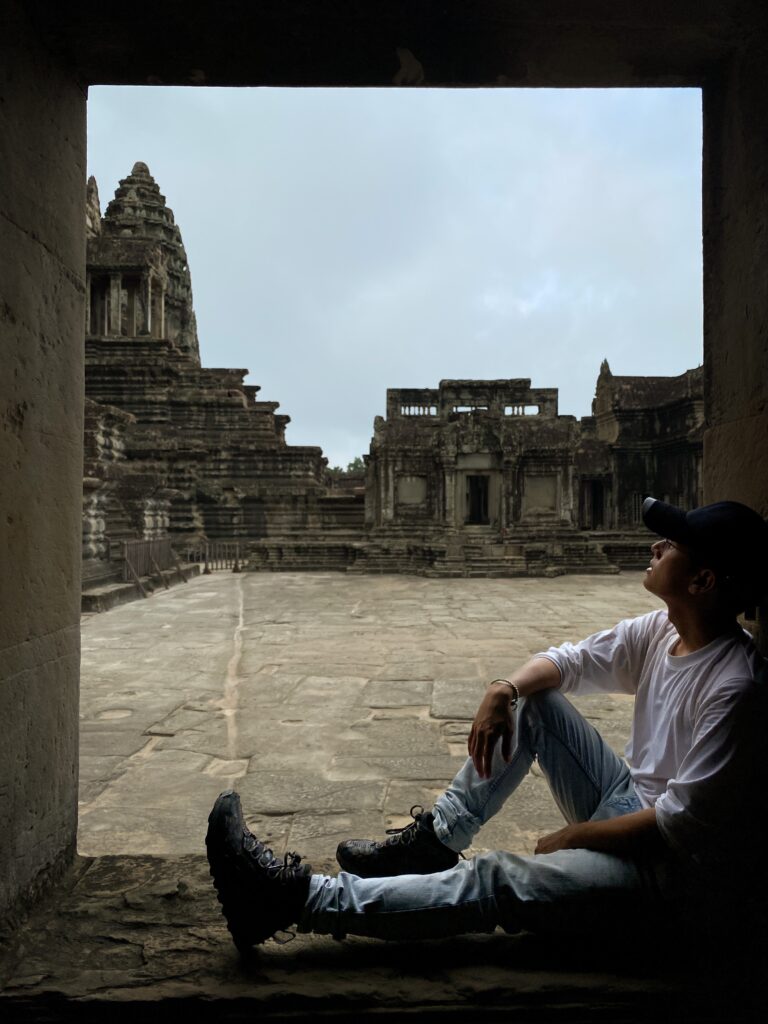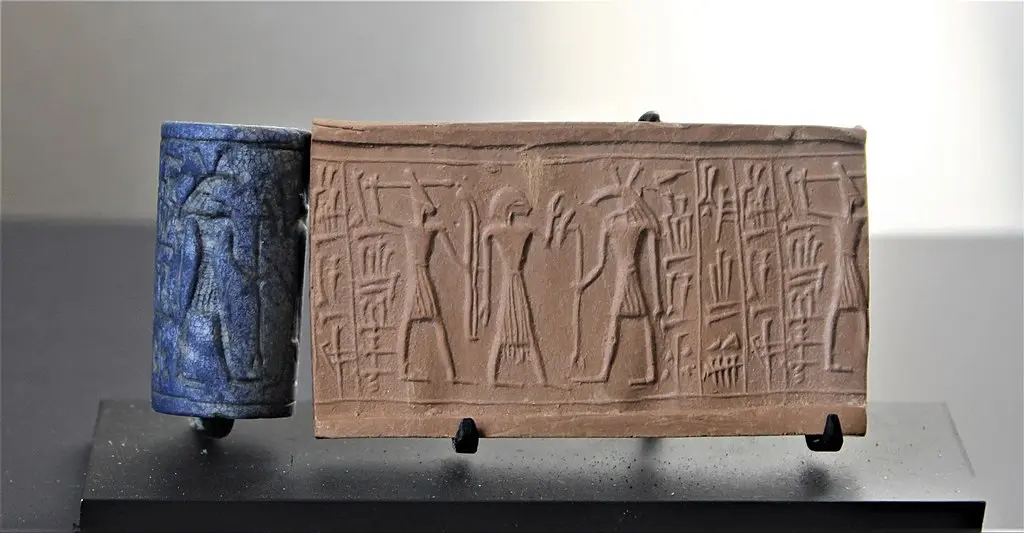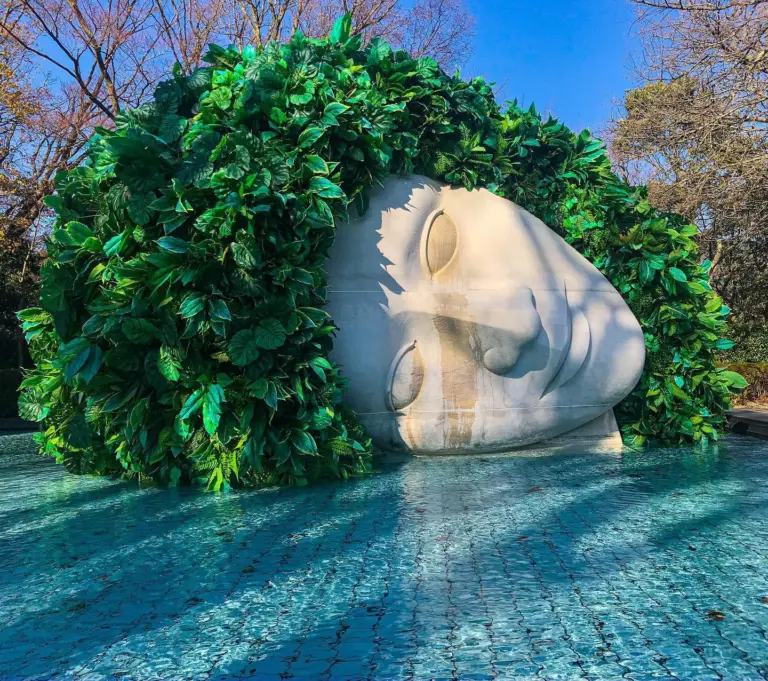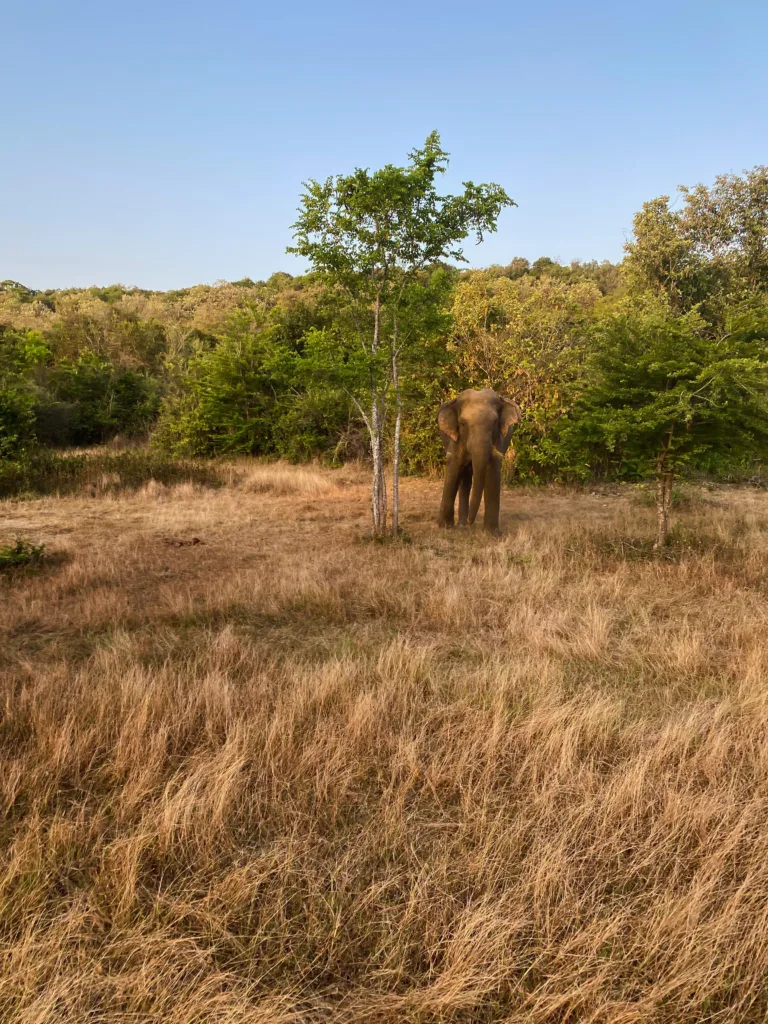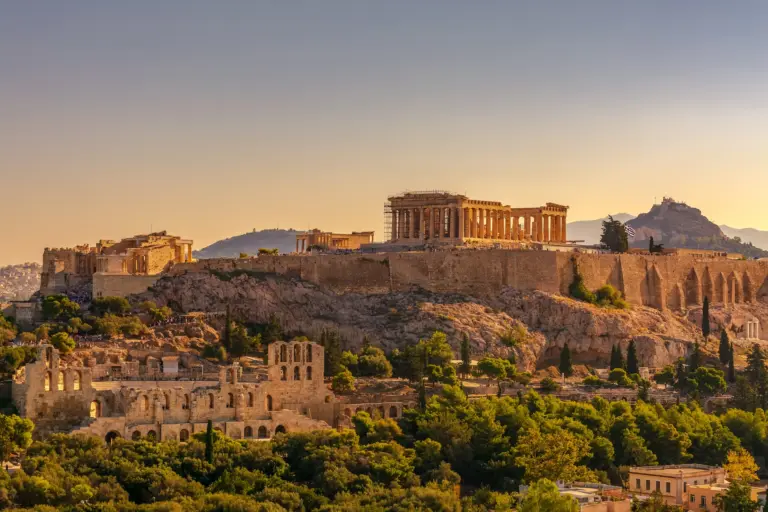Angkor Wat is one of those sites that’s forever etched in my memory. From waking up in the wee hours, cruising in the dark jungle on our e-bikes to catch the sunrise and finally entering and exploring its sacred grounds. The experience was nothing short of incredible.
The weather that day was cloudy, but I’m quite happy with how the shots turned out as the clouds added such a dramatic mood and contributed so much to the “ancient kingdom” vibes. I was able to practice a lot of photography composition and I hope my photos invoke the same emotions from you as Angkor Wat did to me.
You can find our Angkor Wat journey experience here if you’re keen on finding out!
In this blog post, we’re going in deep. You’ll be uncovering incredible facts, history, symbolism and secrets about this amazing temple complex and some extra tidbits on Cambodian culture.
After reading through this, you won’t need a tour guide anymore, in fact YOU can be the tour guide! Let’s start, shall we?
Table of Contents
ToggleWhere to Stay in Siem Reap
Siem Reap is a very small town and you can find most places close to each other and all within 15 – 30 minutes from Angkor Archaelogical Park. Here are some of my recommendations:
Best Hotels in Siem Reap
- Han & Daniel Villa Boutique – this is where we personally stayed and what can I say except that it was a blast! The location is conveniently located near most of the sites that we went to around town such as the Phare Circus and the e-bike rental shop. The rooms were spacious and a good bathroom. The beds were great too. They had parking spaces for our bikes with an in-house restaurant for whenever we were lazy to get food outside. Daniel kindly helped us with a lot of stuff too such as an airport pick-up, airport drop-off, and helping us get tickets to Angkor Archaeological Park. The best part was the pool which we were taking a dip in every day!
- Two Seasons Siem Reap Hotel – offers an outdoor pool, free private parking, and a range of services including room service, a 24-hour front desk, and free WiFi. The rooms are air-conditioned, with a desk, flat-screen TV, and private bathroom.
- Damrei Residence & Spa – offer a flat-screen TV, and a seating area. You can enjoy the garden or city views while relaxing with a cup of tea. All rooms have a private bathroom with bathrobes, slippers, and complimentary toiletries.
- Onederz Hostel Siem Reap – a clean, comfortable, and friendly place to stay. With its well-designed layout and premium amenities, including three swimming pools, this hostel offers a high-quality experience.
- Mad Monkey Siem Reap – offers a range of room options, a fantastic pool, and an incredible bar and restaurant serving both local and Western cuisine. At Mad Monkey, you’ll have the opportunity to connect with fellow fun-loving travelers from all around the globe.
- Lub d Cambodia Siem Reap – featuring a Khmer-chic inspired design, Lub d Siem Reap boasts a swimming pool with a swim-up pool bar, inviting lounging areas, and a games area with a pool table and Pacman arcade game. You can indulge in all-day breakfast, expertly brewed coffee at The PumpHouse, and quick snacks from the Grab & Go counter.
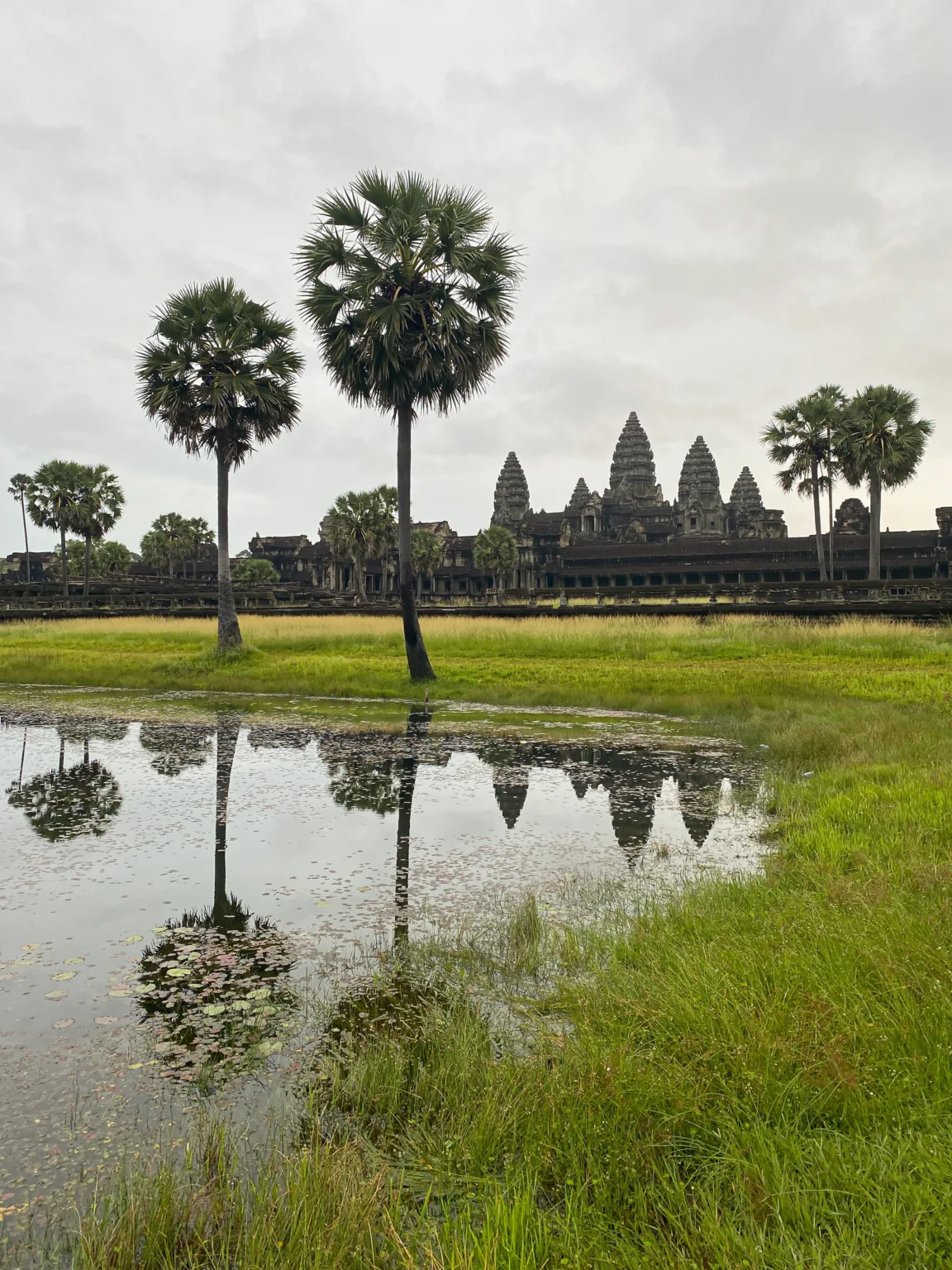
What to Know About Angkor Wat
1. What is Angkor Wat?
Angkor Wat is a breathtaking temple complex and the pinnacle of the ancient Khmer Empire’s architectural prowess. It was conceived in the 12th century by King Suryavarman II.
Renowned for its intricate design and symbolic architecture, Angkor Wat seamlessly blends creativity, religion, and symbolism. Its grandeur extends beyond its imposing size, with meticulously crafted bas-reliefs and stone carvings that chronicle ancient Hindu epics.
If you’re interested, you can join a sunrise plus guided tour of Angkor Wat through here.
2. Where is Angkor Wat?
Angkor Wat is located in the country of Cambodia, in Southeast Asia. More specifically, it is situated just north of the city of Siem Reap, in the northwestern part of the country.
This region, known as the Angkor region, was the seat of the Khmer Empire from the 9th to the 15th centuries and is now known for its majestic temples, with Angkor Wat being the most renowned among them.
Location: Angkor Wat
Opening Hours: 5:00 AM – 7:00 PM
Pro-tips:
- There’s more to Angkor Wat than just the main temple, explore the moats, the jungles, and the surrounding buildings.
- Wake up around 3:30 AM – 4:00 AM to get a good spot to catch the sunrise.
- You can technically enter earlier through a side entrance that’s different from the main bridge’s entrance.
- The time to climb up the towers of Angkor Wat is a bit later than the opening so stick around longer to see the best views in the house.
- Angkor Wat during sunset is also a thing and you can beat the crowds during this time!

3. Why is Angkor Wat Famous?
Angkor Wat is famed for being a profound historical significance as a centerpiece of the Khmer Empire, one of Southeast Asia’s most powerful empire. This alone renders it as a symbol of Cambodia’s rich cultural heritage to the point where it’s literally on the Cambodian flag!

4. Is Angkor Wat Sacred?
Absolutely, Angkor Wat is considered the most sacred site in Cambodia.
Its original construction was as a Hindu temple dedicated to Vishnu, one of the most revered deities in Hinduism. Over time, as the religious landscape of Cambodia evolved, Angkor Wat transitioned into a Buddhist temple.
This multi-faceted religious significance only adds to the sanctity of the place.
5. Angkor Wat Dress Code
Visiting Angkor Wat requires a certain level of respect, given its status as a sacred site. It’s best to wear clothing that covers your shoulders and knees.
While guys can technically wear shorts, you won’t be able to climb up to the towers so it’s best to wear pants if you want to make the most out of your trip to the temple.
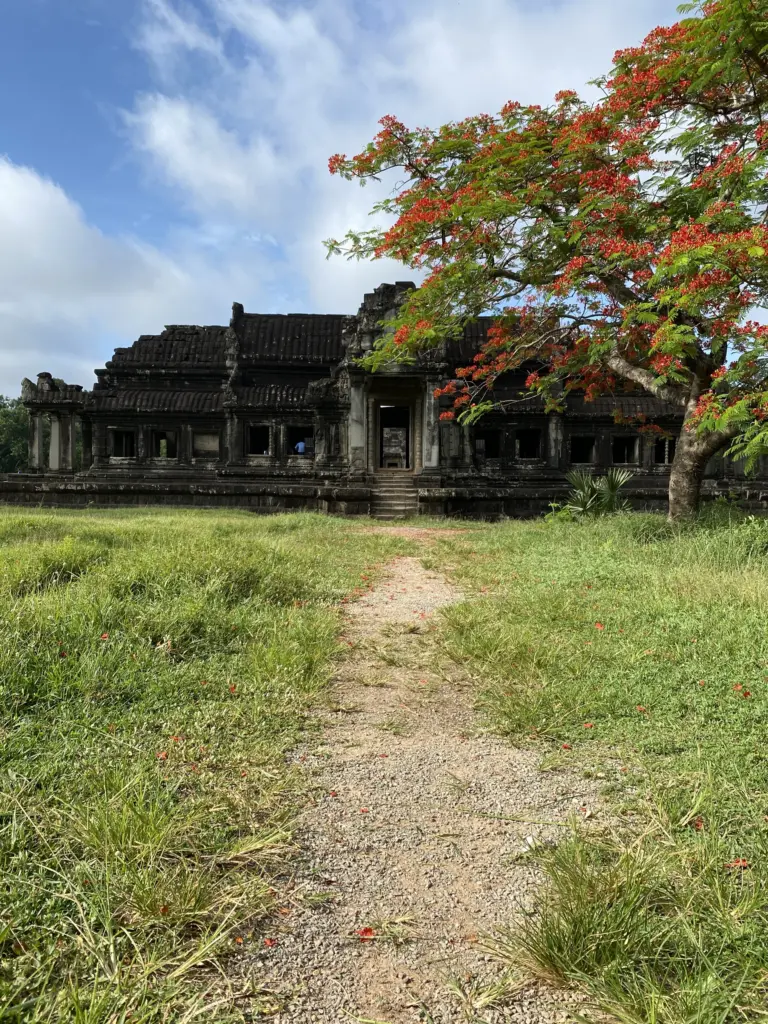
History of Angkor Wat
6. How Old is Angkor Wat?
Dating back to the 12th century, the remarkable Angkor Wat has been standing for over 900 years, making it a significant living testament to the ancient Khmer Empire. Built under the auspices of the powerful King Suryavarman II, the construction is believed to have taken place from approximately 1131 to 1150 AD.
7. Why was Angkor Wat Built?
King Suryavarman II had Angkor Wat built as a place of worship and as a symbol of his power. In those days, kings would often construct grand temples to show their devotion to the gods, and Suryavarman II was a devout Hindu. He dedicated Angkor Wat to the god Vishnu, which was not normal back in the day as most kings dedicated temples to Shiva.
Also, the size and intricacy of Angkor Wat demonstrated the might of Suryavarman II’s rule and the sophistication of the Khmer Empire.
But there’s another reason. It’s believed that Suryavarman II intended Angkor Wat to serve as his mausoleum when he died. So, the temple was not just a religious center and a show of power – it was also a gateway to the afterlife for the king.


8. Why was Angkor Wat Abandoned?
The exact reasons for the abandonment of Angkor Wat aren’t entirely known, but there are a few theories that historians and archaeologists have proposed.
One theory points to environmental factors. The Khmer Empire, at its height, had a complex water management system for irrigation and to control flooding. However, in the early 15th century, the area suffered from a series of prolonged droughts followed by intense monsoons. This likely damaged the water management system, leading to crop failures and instigating the beginning of the end for Angkor Wat.
Another theory cites cultural changes. The shift from Hinduism to Theravada Buddhism, which emphasizes individual enlightenment over ritualistic temple worship, may have reduced the significance of Angkor Wat as a religious center.
Finally, there’s a theory about invasions. The empire had ongoing conflicts with its neighboring kingdoms. In the 15th century, the Thai Kingdom of Ayutthaya invaded and looted Angkor, which may have led to the abandonment of Angkor Wat.
9. When was Angkor Wat Rediscovered?
French explorer Henri Mouhot is often credited with this “rediscovery” during his travels in Southeast Asia between 1854 and 1861. Mouhot wrote extensively about the site, describing its architecture and sculptures. His travel notes, published posthumously, captured the imagination of the Western world.
In reality, Angkor Wat was never really “lost” to begin with. While the city of Angkor was largely abandoned and left to the encroaching jungle, Angkor Wat itself remained a pilgrimage site for Buddhist monks, and it was never fully deserted. Similar to other temples like Ta Prohm (except Ta Prohm was left to be consumed by the jungles) Even when the site was “rediscovered” by the Western world, there was evidence that routine maintenance had been carried out in the interim.
What Mouhot and other Western explorers did was to introduce Angkor Wat to a broader global audience, and eventually leading to concerted restoration efforts.

10. Angkor Wat Timeline
1110 to 1150 AD: Construction of Angkor Wat begins under King Suryavarman II, as a state temple and capital city.
End of 12th century: Angkor Wat gradually transitions from Hindu to Theravada Buddhist use, which continues to the present day.
14th – 15th centuries: Angkor, the capital of the Khmer Empire, is abandoned. However, Angkor Wat itself remains in use.
16th century: Becomes a pilgrimage site and associated with Theravada Buddhism.
1854 – 1861: French explorer Henri Mouhot “rediscovers” Angkor Wat, bringing it to international attention.
1907: The French begin official restoration efforts through the Ecole Francaise d’Extreme Orient (EFEO).
1931 – 1953: Conservation efforts continued by EFEO, but the work is interrupted by the advent of the Cambodian fight for independence from France.
1960s – 1980s: Further conservation work is disrupted due to civil unrest and the brutal rule of the Khmer Rouge.
1992: UNESCO lists Angkor Wat as a World Heritage site.
21st century: Angkor Wat becomes a symbol of Cambodia, appearing on the national flag, and is the country’s top tourist attraction. Restoration and preservation efforts still continue to this day.

Angkor Wat Facts
11. What Does Angkor Wat Mean in English?
Angkor Wat translates to “City of Temples” in English. The term “Angkor” refers to the ancient capital city of the Khmer Empire, which was located in present-day Cambodia. “Wat” is a Khmer word that means “temple.” Quite similar to how Thai call their temples “Wat” as well.
Therefore, when combined, “Angkor Wat” signifies the temple complex situated in the Angkor region.
12. Is Angkor Wat Hindu or Buddhist?
The answer is both! Angkor Wat is a fusion of both Hindu and Buddhist traditions.
If you remember, the temple was initially built as a Hindu shrine dedicated to the god Vishnu by King Suryavarman II.
However, by the end of the 12th century, Buddhism started gaining prominence in Cambodia. As this shift occurred, Angkor Wat transitioned into a Buddhist site and continues to be used as such to this day. You can often spot Buddhist monks in saffron robes and see Buddha statues within the temple complex despite having plenty of Hindu influences still surviving all around. It’s one of the most ancient forms of religious syncretism.

13. How Big is Angkor Wat?
Angkor Wat is massive! This expansive temple complex sprawls across an area of about 162.6 hectares, or roughly 402 acres – that’s larger than 400 football fields! Now imagine, within this vast area, the main temple stands proud, encircled by a wide moat that measures a whopping 200 meters (656 feet) across.
And it’s not just about the land area. The temple itself is a towering structure, a three-tiered pyramid climbing 213 meters (699 feet) into the sky – as tall as a 65-story building.
So, when you’re there, you might have to remind yourself to close your dropped jaw as you take in the size and scale of this magnificent monument. Whether you’re standing afar admiring its silhouette against the sunrise, or walking through the maze-like galleries, the enormity of Angkor Wat will never fail to leave you in awe.
14. Is Angkor Wat the Biggest Temple in the World?
Yes, indeed! Angkor Wat is not only the biggest temple in the world but it’s considered as the largest religious monument in the world, no other temple complex surpasses it in size. It’s odd isn’t it? The largest Hindu temple isn’t even in India!
Whether you measure by the overall area of the complex or the grand scale of the architecture, Angkor Wat certainly takes the top spot.

15. Is Angkor Wat a World Heritage Site?
A resounding yes! Angkor Wat is a World Heritage site, and for good reason! The United Nations Educational, Scientific and Cultural Organization (UNESCO) designated Angkor Wat, along with the wider Angkor Archaeological Park, as a UNESCO World Heritage site in 1992.
This World Heritage status helps to protect the site for the future generations to come!
16. Is Angkor Wat a Wonder of the World?
Yes, Angkor Wat is widely recognized as one of the wonders of the world! Although it is not officially recognized as one of the New 7 Wonders of the World, it is often times referred to as “the Eighth Wonder of the World.” Angkor Wat is often regarded as one of the most impressive architectural and archaeological sites on the planet!
Symbolism of Angkor Wat
17. What Does Angkor Wat Symbolize?
First and foremost, Angkor Wat symbolizes the Hindu universe. The temple’s design represents Mount Meru, the home of the gods and the center of the Hindu universe. The five central towers of Angkor Wat represent the five peaks of Mount Meru, while the outer wall represents the mountains at the edge of the world, and the moat symbolizes the cosmic ocean that surrounds it.
Angkor Wat also mirrors the Hindu concept of the spiritual journey. The path from the outer enclosure (representing the world of humans) to the central shrine (symbolizing the divine realm) is a physical manifestation of the spiritual journey from the earthly to the divine, a passage from ignorance to enlightenment.

18. Why Does Angkor Wat Face the West?
This question has always been a topic of debate. Most Hindu temples are built to face the east, the direction of the rising sun, symbolizing life and rebirth. But Angkor Wat is an exception to this rule. It’s primarily oriented towards the west, which is traditionally associated with death in Hindu cosmology.
This has led many scholars to believe that Angkor Wat was not only a temple but also intended to serve as a mausoleum for King Suryavarman II, who built it. The western alignment would be appropriate for its function as a funerary temple where the king’s mortal remains would rest.
It’s also worth noting that Vishnu, the deity to whom the temple is dedicated, is sometimes associated with the west. So, another possibility is that the temple’s orientation is related to the king’s particular devotion to Vishnu.
19. What is the Astronomical Purpose of Angkor Wat?
Angkor Wat’s complex design also embodies a form of ancient astronomy. The layout and positioning of Angkor Wat reveal a fascinating connection between architecture and celestial alignments, also known as “archaeoastronomy.”
For instance, on the spring equinox, the sun rises directly over the central tower of Angkor Wat, which provides a stunning spectacle and a perfect alignment of the terrestrial and celestial worlds. It’s believed that such solar alignments were used to mark and celebrate key events in the ancient Hindu calendar.
The temple’s towers and passageways serve as a terrestrial model of the celestial world. The spatial arrangement of the towers can be seen to mirror the constellation Draco as it would have appeared at the time Angkor Wat was built. Some researchers suggest this cosmic layout was intended to align the ruling king with the protective celestial dragon, empowering him with divine authority.

20. What is the Cosmology of Angkor Wat?
In terms of Hindu and Buddhist cosmology, the universe is often conceived as a series of concentric tiers, each one representing a different plane of existence.
At Angkor Wat, this idea is reflected in the different levels of the temple, from the outer enclosure to the central sanctuary. As one moves inward, or upward, it symbolizes ascension from the earthly to the divine, moving closer to the gods.
But the celestial reference doesn’t stop at the physical structure. The extensive bas-reliefs found within the temple illustrate scenes from Hindu epics, particularly the Mahabharata and the Ramayana. These narratives are deeply steeped in Hindu cosmology, depicting a world where gods, demigods, and mythical creatures coexist with humans.
Interestingly, Angkor Wat’s orientation towards the west, which aligns with the setting sun, suggests an association with the end of cycles – day gives way to night, life leads to death – and rebirth. This aligns with Hindu and Buddhist beliefs in reincarnation and the cyclical nature of time.
All these elements together reflect the complex cosmological beliefs of the ancient Khmers, Angkor Wat is not just a monument; it’s a snapshot of an ancient cosmological map!
Secrets of Angkor Wat
21. Mount Meru and Angkor Wat
Mount Meru, the mythical mountain that holds the universe together! When it comes to the secrets of Angkor Wat, you simply can’t overlook this one. Angkor Wat is actually a colossal 3D model of Mount Meru. The ancient Khmers built this architectural marvel as an earthly representation of this cosmic mountain.
But why Mount Meru, you might ask? In Hindu and Buddhist cosmology, Mount Meru is considered the axis of the universe, the nexus where heaven meets earth. It’s believed to be the home of the gods, with the mighty deity Brahma residing at the summit (think of Greece‘s Mt. Olympus!)

22. Deities of Angkor Wat
While Angkor Wat is primarily dedicated to Vishnu, there are still a huge pantheon of deities present in and around the temple complex. How many can you recognize?
Vishnu: Vishnu is part of the Trimurti, the Hindu Trinity of Supreme Beings, including Shiva and Brahma. He is known as the preserver and protector of the universe. Many statues and carvings throughout the temple depict Vishnu, and the central tower is considered his celestial home.
Shiva: Although Angkor Wat is primarily dedicated to Vishnu, Shiva, the destroyer and transformer, is also present. Shiva is often represented by the “lingam,” a phallic symbol found in various parts of the temple, you can also find the lingam in Bayon.
Brahma: Brahma is the creator god. While not as commonly depicted as Vishnu or Shiva, Brahma, recognized with his four faces pointing in the cardinal directions, can be spotted in some bas-reliefs.
- Buddha: Despite its origin as a Hindu temple, Angkor Wat later became a Buddhist site. You’ll find plenty of Buddha statues around the halls in holding the Abhaya Mudra. A prominent bas-relief depicts the “Great Departure,” the story of Prince Siddhartha leaving his royal life to seek enlightenment.
-
Yama: Known as the god of death, Yama is prominently featured in the southern gallery’s bas-relief depicting the “Judgment of Humanity.”
-
Indra: Indra, the king of gods and the ruler of heaven in ancient Hindu texts, is found in several places. Indra is depicted atop his three-headed elephant mount, Airavata. You can also find him and his elephant in Bangkok’s Wat Arun!
-
Rama: The hero of the Hindu epic Ramayana, translating to “Rama’s Journey.” Rama is depicted in a series of bas-reliefs in Angkor Wat. You can find there, Rama’s triumph over the demon king, Ravana. To add to that, Rama is one of the human incarnations of Vishnu.
-
Krishna: Krishna, also considered an avatar of Vishnu, is also represented in the bas-reliefs of Angkor Wat. One notable depiction portrays Krishna’s victory over the evil king Kamsa. Krishna is also an important character in the other Hindu epic, Mahabharata.


23. Numerology of Angkor Wat
A part of Angkor Wat’s mystique lies in the way of numbers, particularly the number 9 and multiples of it, are woven into its design. This reverence for numerology aligns with Hindu cosmology, where certain numbers hold sacred significance. For example:
-
Number 9: In Hinduism, the number 9 is considered sacred and is associated with Brahma, the creator. It’s believed to represent completeness and the concept of “nava,” which means “new” in Sanskrit.
-
Number 72: The number 72, a multiple of 9, is also noteworthy in the design of Angkor Wat. This number is often associated with the number of years it takes for the Earth’s axis to shift one degree. Intriguingly, Angkor Wat’s west entrance aligns perfectly with the sun during the spring equinox, a nod to this cosmological cycle.
-
Number 108: Another significant number (and another multiple of 9) in Hinduism and Buddhism is considered holy. There are 108 beads in a Buddhist rosary for counting mantras. Reflecting this, you’ll find 108 lotus bud shaped towers around Angkor Wat.
-
Number 5: The number 5 also figures prominently in the temple’s design (five gates, five towers), which symbolizes the five peaks of Mount Meru.
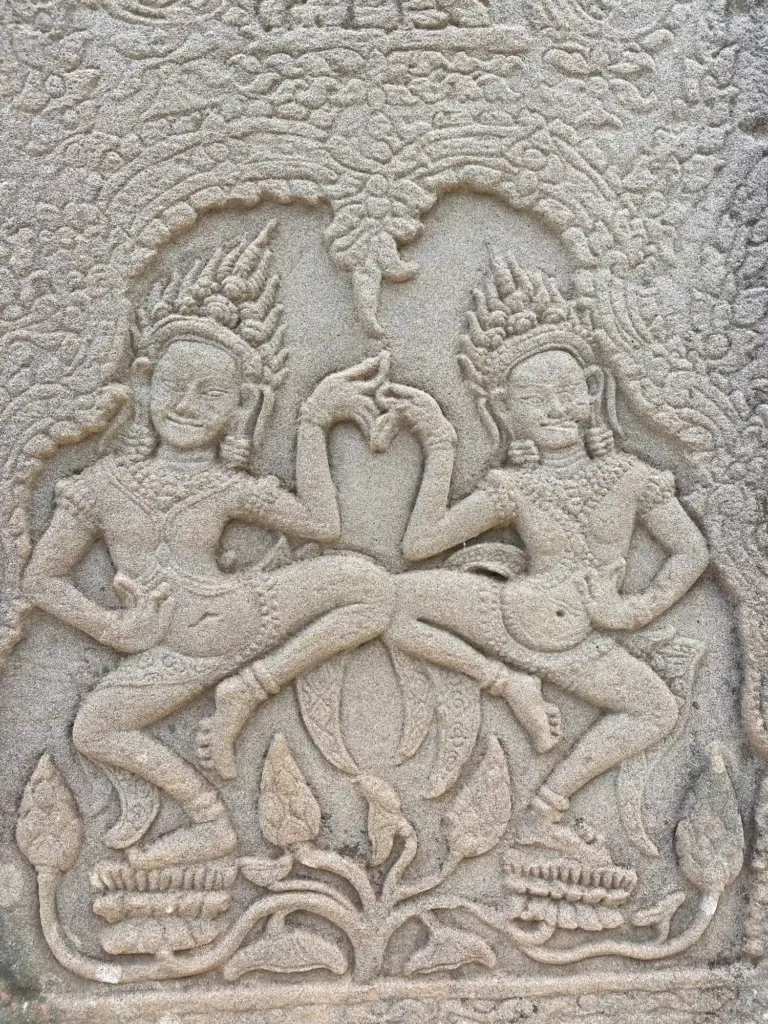
24. Mythical Beings of Angkor Wat
It’s not only gods who are present in the sprawling temple complex. Angkor Wat is also home to several mythological beings from both Hindu and Buddhist traditions:
Naga: Nagas are snake-like beings that are considered protectors, bringers of rain and fertility. In Angkor Wat, you’ll encounter these magnificent creatures in the form of Naga balustrades lining the causeways of the temple.
Apsara: Apsaras are celestial nymphs known for their enchanting dance. They’re considered the entertainers of the gods. There are more than 2,000 carvings of Apsaras Angkor Wat, each one in a unique pose! You can also see the traditional Khmer dance known as the Apsara Dance.
Garuda: Garuda, a large mythical bird-like creature, is known as the mount of Vishnu and a sworn enemy of the Nagas. You’ll find Garudas on the outer walls of Angkor Wat, with their wings spread wide as if they are ready to take flight!
- Devas: Devas are benevolent beings associated with light, goodness, and heavenly realms. They represent positive forces, maintaining order in the universe under the leadership of Indra, the king of the gods.
- Asuras: In contrast, Asuras represent the darker, more chaotic forces of the universe. The term “Asura” is often translated as “demon,” but this simplification doesn’t fully encapsulate the complex role they play in Hinduism. Although they’re often depicted as antagonists to the Devas, they’re not purely evil beings. Good and evil are not that binary even in reality.

25. Mythologies Depicted in Angkor Wat
Angkor Wat is a vast canvas that vividly brings to life famous Hindu and Buddhist stories. The temple walls are adorned with really intricate bas-reliefs that show several key moments. Here are some of the most significant ones:
-
The Churning of the Ocean of Milk: One of the most famous and spectacular bas-reliefs at Angkor Wat, it depicts the epic tug-of-war between Devas (gods) and Asuras (demons) using the serpent Vasuki to churn the primordial ocean, aiming to produce the nectar of immortality, Amrita. This scene symbolizes the eternal struggle between good and evil.
-
Heavens and Hells: This is a vivid depiction of the Hindu concept of karma and afterlife. It showcases Yama, the god of death, presiding over the judgement of souls and it shows the rewards of heaven and torments of hell.
-
Vishnu’s Victory over Demons: This relief shows Vishnu in his four-armed form, triumphing over an army of Asuras, showing the victory of divine order over chaos.
-
Legends of Krishna: Various exploits of Krishna are showcased in different bas-reliefs. Notable among them is the tale of Krishna lifting Mount Govardhan to protect the villagers from Indra’s wrath.
-
The Ramayana: Known as “Reamker” in Cambodia, the Ramayana has had a profound influence not only in Cambodia but also in other countries such as Indonesia (Kecak Dance), Thailand (the Ramakien and the Khon Dance), and even Malaysia (Wayang Kulit Shadow Puppetry). At Angkor Wat, the “Battle of Lanka” scene from the Ramayana is depicted on a large scale. If you want to learn more about the Ramayana, you can click here.
-
The Mahabharata: The Mahabharata’s influence is equally apparent. One of the most important sections of this epic, the “Battle of Kurukshetra,” is vividly depicted on the gallery walls. The scene shows the grand warfare between the Pandavas and the Kauravas, where Krishna serves as the charioteer for the Pandava prince, Arjuna.
Plan Your Trip to Siem Reap | Best Travel Resources
Book Your Accommodations
- Booking.com – the world’s leading online booking platform for accomodations around the world, they have an extensive amount of available listings with zero booking fees and best price guarantees.
- Hostelworld – a backpacker’s best friend, Hostelworld has the largest collection of hostels and guesthouses for affordable prices.
Don’t Forget Insurance
- SafetyWing – from Nomad Insurance, an insurance by nomads for nomads. They understand our lifestyle well and have really comprehensive and flexible plans that cater to any traveler.
Find Cheap Flights
- Kiwi.com – my go-to for booking and finding the cheapest flights and it’s helped me save tons of money. They do virtual interlining which is connecting flights from airlines that do not codeshare, so you can find routes that you wouldn’t be able to find normally.
Join Tours & Activities
- GetYourGuide – is one of the best places to find unique tours and activities. I found that it’s an excellent way to meet fellow travelers and create fond memories. They are not only limited to tours as they also offer niche services such as skip-the-line tickets or private transfers.
Catch a Ride
- Rentalcars.com – nothing beats the freedom of the road, Rentalcars.com is the world’s largest online car rental service. They operate across 160 countries so they’re the perfect partner to work with if you find yourself wanting a ride.

